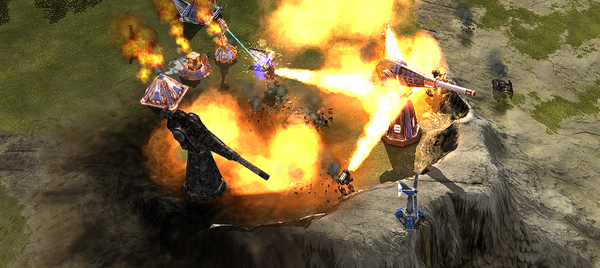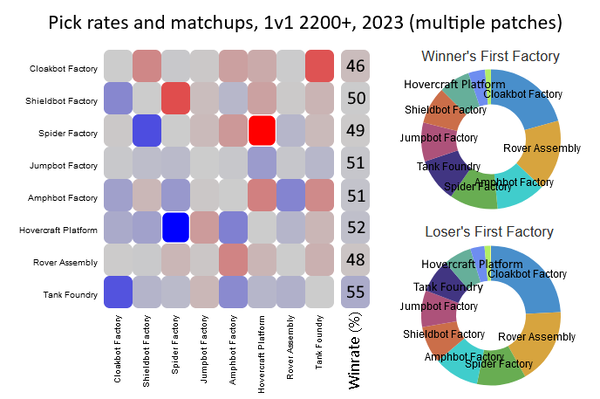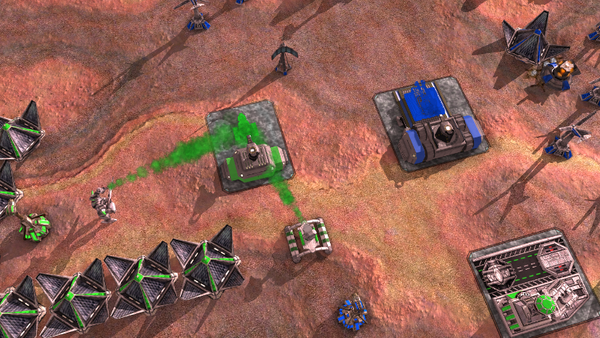Cold Takes/4 - Factories as Factions
How many factions are there in Zero-K? I get asked this from time to time and am never quite sure how to respond. It looks like a simple question with a simple numerical, like two or seven, but it is actually quite complex. The questioner may not stick around for the full answer, and I might not have the time to give one, so what am I to do? Finally I have the solution: just link this post.
Strictly speaking, Zero-K has one faction, but in many ways it has somewhere around eight to eleven. Many parts of the game are designed to satisfy most of what people want from factions, and it is these desires that lead to questions such as how many factions are there in Zero-K?
. This is why I have such trouble just answering "one", as it gives the incorrect impression that we have nothing to offer people who like games with many factions. The faction-like entities of Zero-K are the eleven factories that produce most of the units in the game.
Here is a quick overview of factories.
- There are eleven factories: three for walker robots, two for vehicles, one for spiders, two for amphibious units, two for aircraft, and one for ships.
- Your first factory is built for free, instantly.
- The land and sea factories have enough variety to see players through to at least the midgame.
- The air factories are designed to support the other factories.
- Factories are expensive enough to dissuade people from building extra factories until the midgame.
- Production rate is best boosted by assisting with constructors, using construction turrets, or adding cheap parallel production plates that depend on the main factory.
Essentially, a factory is a technology structure that unlocks a "faction" of approximately ten units, and these "factions" are designed and balanced in much the same way as a faction from any other game. This has been called a soft faction system, since players start the game with one faction, but are free to dip into any others later in the game. It is similar to the way factions work in card games like Magic: The Gathering or Android: Netrunner, which have both distinctive faction and flexible deckbuilding systems that technically allow any two cards to appear in the same deck. Zero-K has a similar sense of factions, with the big distinction being that the decision to dip into a faction is made during the game itself.
I would like to go into the history of how factories as factions came about, and will some day, but it touches too many parts of Complete Annihilation to cover in one post. For now just know that CA had two factions, and that Zero-K was born from the idea of condensing them into one. The original motivation was to reduce the amount of art we needed, but the idea quickly grew into a design direction that was justified in its own right. This justification is just as valid today as it was back then, so I can cover it without too much background. Then, when it is time for the background, I can refer to this post. There is a plan here, so it might not surprise you to hear that the two pillars of factories as factions are Quant's Rule and avoiding fights between the player and the UI.
The two factions of CA, Arm and Core, go back all the way to Total Annihilation, and they had quite a lot of overlap. Faction diversification was a major goal of CA, and we were making good progress by applying Quant's Rule across the game as a whole, as well as by adding new faction-exclusive mechanics (such as area shields and cloakers). There was a limit to this though, since each faction needed access to everything required to play a full game. It is also hard to differentiate factions without creating powerful cross-faction combinations, since differentiated factions naturally cover each others weaknesses. This was particularly evident in team games, since each team almost always had players of each faction. Any difficulty in coordinating the units from different factions was just considered a UI limitation. So the principle of avoiding fights with the UI was telling us that team games already has a single faction - the full unit pool of the game. Worse, this faction still had very similar Arm and Core versions of many units, which goes against Quant's Rule.
The Nuke Silo is a good example. Core, being all about brute force, had a larger and more expensive nuke than Arm. We could try balancing each into a distinct role, but there is a limit, since both factions need a full set of lategame options for when they are played on their own. A Core player might decide the team needs an Arm nuke, but to build one they have to ask a teammate to share a constructor, which is a terrible situation as few people play RTS to fiddle with the unit transfer UI. Situations like nuke occurred across CA. mostly for structures, but also for many staple units as such as the basic Raven-like bomber or the Ravager-like assault vehicle. In each case we either gave each side a perfect duplicate, which works for Wind Generators but is a bit unsatisfying for nukes, or we end up with a Quant's Rule violation plus the possibility of fighting the UI.
Most issues caused by factions were avoided in 1v1 since each side was truly only Arm or Core. In fact, condensing the factions was seen as an improvement for 1v1, rather than a fix, as condensing the faction would allow for a wider range of factory designs. In CA the capabilities of Arm and Core had to be fairly closely balanced, since one being clearly better on a particular map type would be unacceptable. So CA had four choices of initial factory in 1v1, a bot and vehicle factory for each faction, but each of bots and vehicles had to behave fairly similarly across the factions. It was not so bad that it felt like only two options, but it did not feel as diverse as a full set of four options either. Simultaneously balancing factories individually and across the factions was restrictive, since anything added to one faction needed some sort of equivalent in the other. With Zero-K we removed the restriction of factories fitting into a larger faction, so we were free to design each factory independently. It took some time to get here, but it paid off, as we now have eight land factories, each more unique than anything seen in CA. Players certainly treat the factories like factions, arguing about their viability and complaining about particular matchups, just as they would for factions in any other game.
The remaining PvP game mode, free-for-all (FFA), was wild, and we might have lost something here by treating factories as factions. Might. I remember a match that soon turned into a 3-way Core-only game on Comet Catcher, between Saktoth, det and I. As Core we had shields, but lacked the EMP weapons to break them. The game was at least three hours long, Zenith was not enough, and approaching the shields stealthily was not an option either since area cloaking was Arm-only. I forget who won, but there was a turning point when det found and resurrected an Arm constructor from a defeated player. I have fond memories of this game, but largely because it was exceptional. Most FFA games were played with all the units, since Arm constructors could capture and Core constructors could resurrect. Saktoth summed it up in a thread about condensing the factions.
I just played a FFA where i started core ships, went core walkers, lost both those factories, ressed an arm con, went arm tank for a while and was down to a single Freaker for core tech. Made core tank factory, lost my arm tank Factory to nuke, played core tank for a bit, got an arm air con, made an arm shipyard, lost my core tech entirely, took over the sea, made an arm air plant, and captured a core hover con for the grand finale where i built a zenith.
The factory diversification enabled by merging Arm and Core was unexpectedly beneficial for team games. There are now enough distinct "factions" for each player to feel like they have something unique to contribute. Consider a large team game on a wide open map. In CA, most players would play Arm or Core Vehicles, with some air support, and maybe a few playing bots. In Zero-K, the most straightforward options are Rover, Tank and Hovercraft, which already feels nearly three times as diverse as Arm vs. Core vehicles. There are even more options though, as Cloakbot and Shieldbot work well anywhere, and there are niches for the remaining three factories to fill even on a wide open map. In general, any of the ten factories feel viable (eleven if there is enough water), which makes it highly unlikely that the players on any given front end up in a mirror match. It feels good to be one of the few players in a team with your set of units, it gives you a distinct role, and this is most of what I want from factions.
The UI has also benefited greatly from treating factories as factions. Giving every constructor the same set of build options is amazing, it just solves so many UI problems before they arise. The build options are always in the same spot, with the same hotkey, and players no longer have to hunt around to find the right constructor to build what they want. Admittedly, condensing the factions also bloated the build list since we could not bear to discard the unique turrets. But I am sure many people see this as a benefit as well.
I sometimes worry that continuing to remove UI limitations will eventually remove the faction-like feel that we have managed to create. Factory plates were particularly worrying. These are a recent addition that lets players make cheap extra factories of the same type, using the main factory as a sort of tech hub. Factory plates can be placed for allied factories, as anything else would be a UI limitation, which makes switching into the factory of a teammate much easier. Thankfully, the faction feeling survived, and if factory plates are unable to kill it, then perhaps nothing can.
There was opposition to factories as factions at the time, with some people even predicting that it would kill the game. Their main concern was that we lost the benefits of overall faction identities, the way a set of factories for Core or Arm that share design elements. People weigh things up differently, but I think this was a fine price to pay, and it has worked out better than anyone could have predicted. At this point we would not split Zero-K back into two factions, even if the art required for the extra structures magically appeared. I think Zero-K is about creativity, and stopping players mixing and matching units from any set of factories feels like it goes against that. This is before considering all the Quant's Rule violations and UI fights that splitting Zero-K would generate, and the fact that CA team games were secretly one faction all along.
Again, apologies for glossing over the history, but this felt like enough for one post. It does create the opportunity to play a game in the comments though: try to guess the original faction of Zero-K units, using TA, BAR, or anything in between as a guide. Remember, the faction "Zero-K Exclusive" is an option, and to give a hint, if that were a faction of old CA, then it would be ridiculous and barely playable.



